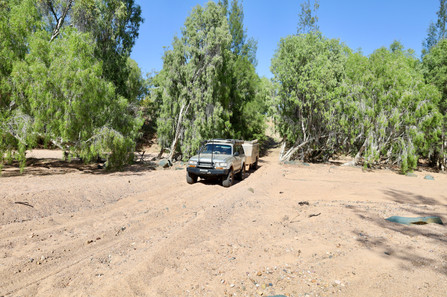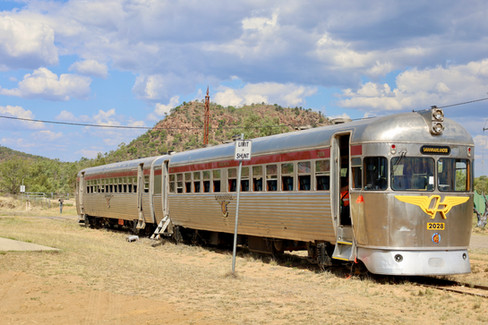GEORGETOWN AND MORE ... QLD
- Woolgoolgaoffroad
- Nov 15, 2022
- 7 min read
I’m pretty blown away sometimes by where my travels take me and what there is to find once I start digging. After another trip up to Cape York, I thought I would head west towards the Gulf before the weather started getting too hot.

Georgetown, about 400km west of Cairns in far north Queensland is a popular stop for travellers heading east or west and from the outside, this sleepy town really doesn’t seem to offer much, but history dates back 153 years when gold was found on nearby goldfields.
In 1869 more than 3000 prospectors were on the field known as Etheridge, this was changed to Georgetown after the assistant gold commissioner, Howard St George. The town exploded into life with schools, a telegraph repeating station and by 1876 a reported 28 hotels. These were times when plenty of gold was found and mines were put on the London Stockmarket to raise more money to float the goldmines.

Today Georgetown and the surrounding areas are a pretty cool place to explore and I found it was easy to spend a week here. In the town itself, the best place to start is the local info centre where they not only can help with the regions attractions but you can spend time in the Ted Elliot Mineral collection. This is a huge private collection of over 4500 different minerals and gems that Ted has collected which is regarded as the best in Australia.
Other places to check out in town include the Ant Bed House which was built in 1889 using Termite mound material instead of mud. Now Heritage listed, it's currently being restored to its former state. Down near the Etheridge River a 5-head stamper battery and other mine gear located where the Nugent brothers used it until 1941. There’s also the river walk, historical buildings, the Georgetown peace monument and mine relics in the local park.
CUMBERLAND MINE AND CHIMNEY
The Cumberland Chimney 20km west of Georgetown is all that's left of the gold-crushing plant and mine built by Cornish miners in 1899. In its day, the Cumberland Mine was the largest and most successful of all the gold mines on the Etheridge field. Large steam-driven engines powered the huge stampers that crushed the rock that came from over 1000 feet underground.

A claim was registered in 1872 and 14 years later sold to the Cumberland Gold Company which put it on the London stock market to raise more funds. The township of Cumberland was huge, originally growing from a miner's camp it grew to over 400 people living nearby with families and other workers calling it home. There were three banks, a telegraph station, four hotels and a school. Just nearby a dam was created to catch water for daily use and for the mine, today it's a refuge for migrating birds.

But it was only a few years later the gold ran out, floods and droughts demised the area plus shareholder funds ran out. By the turn of the century the flurry of activity stopped when the company was abandoned, families moved away in search of a better life then schools closed due to the lack of kids.
FORSYTH
Leaving Georgetown I headed south to the historic town of Forsyth where the mining history reads much the same as Georgetown. Originally called Finnigan’s Camp after the prospector who found gold back in 1871, it was then named Charleston Township which kept growing even after prospectors headed to the rich goldfields in Cape York in 1874.

Promising Copper deposits were found in the area and as far north as Chillagoe and this led to a rail link between the settlements which further opened up the area. It was around the turn of the century when the town was renamed Forsyth after the railway's commissioner and in the same year, buildings that were across the river were moved to Forsyth.
When the huge Chillagoe Smelters were shut down in 1914, Forsyth remained an important railhead to the west and there was a plan to extend the line to Georgetown but this didn’t eventuate. Today, Forsyth is a service centre for road transport and tourism. The Goldfields Hotel is the original hotel dating back to 1917 and is a popular stop in town.

Across the road at Caschafor Park, there’s a stack of mining and railway heritage that you can self-discover. The rail line doesn’t see any commercial goods trains these days as cattle are transported across to cairns by huge road trains.
Since 1995 a tourist rail motor with carriages, the Savannahlander, operates between Cairns and Forsyth on a weekly service. My original plan was to head east towards Einasleigh but finding out it was nearly all tar, my second choice was to loop south through Rungulla National Park, old mines and maybe dabble in a little fossicking.
HEADING SOUTH
Leaving Forsyth, my trip took me down past Cobbold Gorge where on a private station you can explore stunning narrow gorges amid ruggered 30-foot high sandstone formations. This place is as popular as anywhere on the east coast and unfortunately, their tours were booked out, so I missed out this time.

Cruising further south along Cobb Road, I was amazed at the beautiful scenery when the road rose sharply on steep pinches. Across the distance towards Rungulla, the landscape is ancient with jaggered ranges and wide dry river beds.
Before getting to Rungulla I decided to spend a few days at Agate Creek Fossicking area where with cheap camping it's silly to go straight past.

The designated campsite is impressive with huge amounts of room, flushing toilets and hot showers. Owner, David Terry has done an amazing job setting aside this parcel of land. Agate Creek is known for the stunning Agates and Thunder Eggs found in the area left behind from volcanic activity millions of years ago.
At the camp area entrance, there are free detailed maps on where to go to dig gems and the 4wd tracks, which makes life a lot easier as there’s just a maze of tracks and creeks to explore
Leaving Agate Creek to head further south, it's only about 30km to Rungulla NP. The park does have remote camping down near the beautiful Gilbert River where for most of the year it's wide, sandy and dry.
At the entrance of the park, there's a detailed info board on the park plus a short walk to the cultural Madha ( mountain ) site where the Ewamian people lived for hundreds of years.

Scattered throughout the park there’s rock art stencilling done by the Ewamian people, and they have allowed access to one of their sites with a host of different prints and objects.
Heading out of Rungulla it was interesting to find memorials from the old Ortona copper mine that operated in this hospitable country between 1890 and 1970.

According to the sign there was hotel, a shanty village and not much else. Back in its heyday the ore was carted across to Townsville, where it took 6 long weeks with steel wagons, with up to 20 Clydesdale horses with the men walking beside the teams covering the 330 miles to the coast.

When the rail line reached Forsyth the wagons just had 60 miles to cart the ore, then came the trucks from 1930 until the closure of the mine. Another monument I came across was one for John McKinlay who was searching for lost explorers Burke and Wills in 1862, beside a trail named after him.
An hour south of Einasleigh is the huge Kidston gold mine that shadows the surrounding landscape. Not active as a gold mine anymore but is being converted into a massive hydro and solar plant.

Once called the Oaks Goldfields, payable gold was found and the town was built near the Copperfield River, sadly today the old town and heritage mining gear are off-limits to the general public. Copperfield dam that was originally built for the town's water supply is accessible with free camping, it's known for its giant Redclaw and boating on the dam.
HEADING TO EINASLEIGH
It's only another 50 km to Einasleigh that was named after the local river by explorers in 1864 on their Rockhampton to Cape York expedition. Once a fairly significant town, Einasleigh has now faded away to just having a pub and a handful of houses in the district.
But back in 1866 huge amounts of Copper was found near the Newcastle range and the town flourished until the Copper ran out. The narrow gauge rail line to Chillagoe transported the minerals to the huge Chillagoe smelters, but when they stopped working the Einasleigh mine also closed.

Today it's a popular stopover for the Savannahlander tourist train that stops near the pub twice weekly, also nearby is the beautiful Copperfield Gorge that’s the remnants of an ancient lava flow on the southern boundary of the Undara lava fields.
Now while it would have been just as easy to head to Einasleigh from Forsyth in a direct 1-hour route, my southern loop trail lead me to some pretty cool locations and amazing history. This is one trip I’d definitely do again.
FAST FACTS
WHERE
Georgetown is 1800km northwest of Brisbane, midway between Karumba in the gulf and Tully on Queensland's east coast. These vast dry savannah lands hold a lot of Australian pioneering history and some amazing scenery to boot.
WHAT TO SEE AND DO
The whole area has so much to offer from exploring the heritage around the towns, and natural scenery with deep-set ancient gorges, through to dabbling in gemstone collecting. There's plenty of camping, hikes, discovering the area's relics, 100-year-old mining history plus getting back to nature.
OTHER INFO
Apart from a stack of info online from a multitude of websites, I found the info centre at Georgetown was extremely helpful with maps, data sheets and could even help with organising paid tours around the area. They can be found in Low Street, Georgetown or by calling 07 40621485. At Forsyth and Einasleigh the pubs were the go-to place for local info in their areas. During wet times the area may be cut off and I would avoid the area in summer as the temperatures would be unbearable.











































































Comments